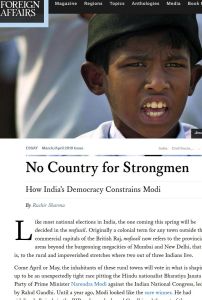Join getAbstract to access the summary!

Join getAbstract to access the summary!
Ruchir Sharma
No Country for Strongmen
How India’s Democracy Constrains Modi
Foreign Affairs, 2019
What's inside?
Autocracy might be on the rise, but not in the world’s largest democracy.
Recommendation
In spring 2019, India’s 900 million registered voters will have the opportunity to cast their vote on who will govern the world’s largest democracy for the next five years. The two main contenders, the incumbent Bharatiya Janata Party and the Indian National Congress offer two radically different visions for the country: a singular Indian identity versus a celebration of the country’s multi-ethnic character. But regardless of who wins, writes India expert Ruchir Sharma, India’s democracy is robust enough to withstand any attempt by a ruling party to shift the country toward autocratic rule. His analysis provides first-hand insight into India’s complex political dynamics.
Summary
About the Author
Ruchir Sharma is Head of Emerging Markets and Chief Global Strategist at Morgan Stanley Investment Management and the author of Democracy on the Road: A 25-year Journey Through India (2019).


















Comment on this summary